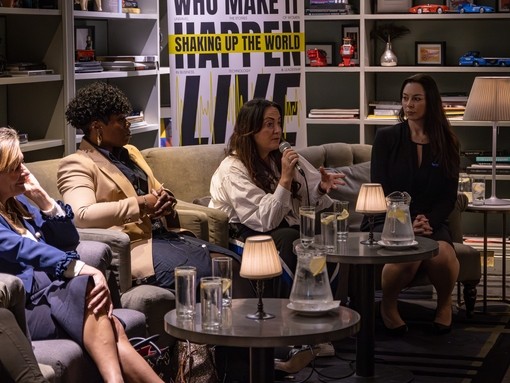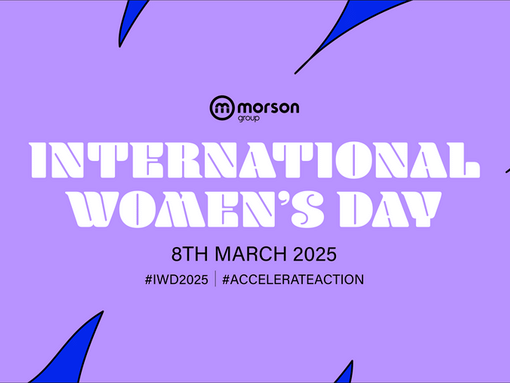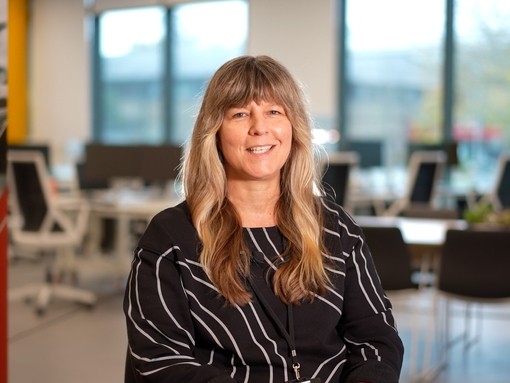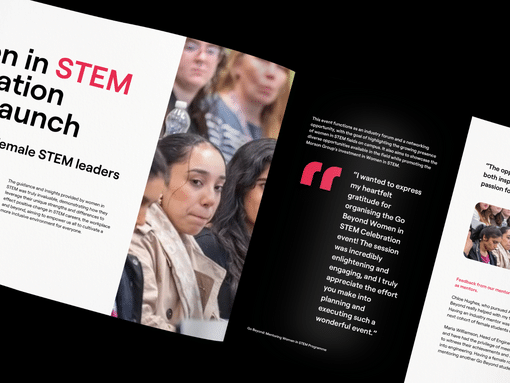
Thriving through change: Carla van Sintfiet’s unstoppable journey to success
Contents
- From science to economics and a career in finance
- Building a career in uncertain times
- Navigating mergers, management and work-life balance
- Stepping into leadership
- Balancing career and family life
- Adapting risk management to the digital age
- Enterprise risk management – a strategic enabler
- An inspiring career built on balance, growth and resilience
Contents
Imagine career shifts from molecular genetics to finance, from risk management to the cutting edge of digital assets… sounds impossible? Not for Carla van Sintfiet. She has reinvented herself time and time again, proving that adaptability isn’t just an asset - it’s a superpower.
The Women Who Make It Happen: Journeys to Success is a series spotlighting women who have carved out extraordinary careers, overcoming obstacles and navigating complex, often unpredictable paths. In this episode, Anna Massey spoke with Carla van Sintfiet, Head of Enterprise Risk Management, to uncover the pivotal moments, mindset shifts, and lessons that have fueled her rise.
With over 15 years of expertise spanning asset management, banking, and fintech, Carla has shaped the future of risk management, specialising in crypto assets and financial derivatives. But beyond the boardroom, she opens up about the balancing act of career and family, the lessons hidden within life’s toughest challenges, and the mindset needed to thrive. Few careers take as many twists as Carla van Sintfiet’s. Yet, through every shift she has embraced change with infectious enthusiasm and an unshakable belief in the power of reinvention.
From science to economics and a career in finance
Carla’s journey didn’t follow a straight line – it was a series of unexpected turns.
It all started in high school, where she excelled in math, biology, and chemistry, leading her toward a future in genetics. With top grades, she secured a spot in a prestigious molecular genetics program, seemingly set for a career in scientific research.
But then, a single elective in macroeconomics changed everything. Captivated by the subject’s logic and structure, Carla found herself deeply fascinated; she would arrive early to class just to talk to the professor about it. The more she learned, the more she questioned her path in genetics.
By year’s end, Carla faced a tough choice. She had already lined up a summer job in a genetics lab and a spot in a master’s program but her growing passion for finance couldn’t be ignored. It was only during an internship in Prague that she gained the clarity she needed: “That summer in Prague was a turning point for me in more ways than one,” she admitted. There, a chance meeting with a Dutch traveller – who would later become her husband – helped her see the way forward. His advice to trust her instincts over a set path struck a chord.
By the end of the summer, Carla had made a game-changing decision: complete her genetics degree but ultimately transition into economics and finance, setting the stage for a career defined by bold moves and limitless potential.
Building a career in uncertain times
With a clear sense of direction, Carla pursued a second degree in economics, majoring in finance. But just as she graduated, the 2008 global financial crisis hit. The collapse of Lehman Brothers sent shockwaves through the industry, freezing job markets and plunging financial institutions into chaos. Reflecting on this turbulent time, Carla said:
It was a chaotic but incredibly interesting time. Every time you checked the news, there was another major event unfolding.
Despite the economic uncertainty, Carla remained determined. Leveraging her academic achievements and research experience, she secured a role in risk management at ING (Dutch multinational banking and financial services corporation). Her responsibilities included monitoring nearly 300 UCITS funds, ensuring compliance with strict regulatory requirements, and working closely with the front office.
Seeking deeper expertise, Carla embraced the challenge of pursuing the Chartered Financial Analyst (CFA) certification while managing a demanding job. “Back then, I had no life – it was just work and studying,” she admitted, laughing. Yet, looking back, she acknowledges that the experience was invaluable.
Then, a former colleague nudged her toward a role at Shell, where she transitioned into corporate risk management. If that wasn’t enough, around the same time, she took on yet another challenge – pursuing a Master’s in International Finance at the UVA (Universiteit van Amsterdam) while continuing her full-time job and CFA studies. “I was incredibly busy – working full-time while studying, continuing my CFA, and managing my master’s coursework all at once. It was a challenging but rewarding period,” she said, proving that determination and willingness to try new things can truly pay off.
Upon completing master’s, Carla moved to Aegon Asset Management as a Senior Portfolio Risk Manager, overseeing fixed income strategies such aps mortgages, private loans, and asset-backed securities (ABS). She worked closely with the front office, particularly on Aegon’s mortgage fund, one of the firm’s most successful investments.
Navigating mergers, management and work-life balance
Carla’s expertise and growing reputation led her to another opportunity at Aegon Bank. But just as she was settling into her new role, a major shift occurred – the announcement of a merger between Aegon Bank and Knab. While the process had been in motion for two years, its finalisation brought significant organisational changes, including a company-wide restructuring and relocation. Many employees faced uncertainty, and some opted to leave rather than relocate. But instead of viewing the transition as a challenge, Carla saw it as an opportunity:
There was a lot of work to be done to facilitate the transition. It was a period of major change and adjustment, but also an exciting and dynamic time to be part of the organisation.
Mergers are notoriously complex, often leading to disruptions in operations, overlapping responsibilities, and the need for swift integration of systems. Carla experienced this firsthand in 2019 when the merger officially took place, but she quickly realised that the groundwork had been laid much earlier.
By 2017, a regulatory review had highlighted key compliance issues that the bank needed to address. By the time Carla joined, efforts were already underway to resolve these findings and strengthen the bank’s risk framework. She was immediately thrust into high-priority risk management projects, all while navigating the structural shifts caused by the merger.
As departments restructured and roles evolved, Carla’s responsibilities grew. Having previously contributed to an in-house risk management system at Aegon Asset Management, she had a solid foundation in regulatory frameworks. However, working in banking brought her even closer to the complexities of financial compliance. The rapid changes within the organisation gave her an opportunity to expand her expertise beyond market and liquidity risk, gaining exposure to a broader range of banking operations.
With each challenge came growth, and after several years in the role, Carla was ready for the next step.
Stepping into leadership
Carla’s next move took her into a vastly different environment – a Japanese wholesale bank. The transition was a stark contrast to her previous experiences, as this institution specialised in facilitating investments between Japanese and European clients. Operating in such a niche sector came with new complexities, but also an opportunity to step into a leadership position.
As Head of Risk, she was responsible for overseeing financial risk (liquidity risk, FX risk, market risk), non-financial risk, data protection, and information security. What excited her most about the role was the chance to broaden her expertise. At Knab, she had primarily focused on liquidity and market risk. But in this position, she had a much wider scope, managing risk across multiple areas, including operational resilience and cybersecurity.
Her previous experience in asset management and banking had already exposed her to operational risk and regulatory compliance, and those insights became invaluable as she took on greater responsibilities. At Mizuho Bank Europe, she was responsible for delivering the bank’s SREP (Supervisory Review and Evaluation Process) to the Dutch Central Bank, which included the Internal Capital Adequacy Assessment Process (ICAAP), the Internal Liquidity Adequacy Assessment Process (ILAAP), and the Recovery Plan. She also conducted stress testing and oversaw data protection and cybersecurity frameworks.
Taking on a leadership role required more than just technical knowledge. It demanded strategic thinking, strong decision-making, and the ability to guide teams through complex regulatory environments. Carla’s ability to navigate uncertainty and adapt to new challenges set her apart, preparing her for the next, and perhaps most ambitious, career transition:
Looking back, it has been an intense but rewarding journey, filled with constant learning and growth.
With years of risk management experience across asset management, banking, and fintech, Carla was ready to take on a challenge unlike any she had faced before. As a Head of Enterprise Risk Management at Deribit, she had the opportunity to build an entire risk management framework from the ground up. Reflecting on this pivotal moment in her career, she put it this way:
Having worked at mature organisations where established frameworks were already in place, I was now able to apply everything I had learned over the years to create a robust system from scratch.
Balancing career and family life
Beyond her professional achievements, Carla has also mastered the art of balancing a demanding career with her family life. As a mother of two young children, she has developed an approach that allows her to ‘juggle’ both responsibilities successfully:
I often think of it like juggling – some balls are made of glass: if you drop them, they break, and the impact is significant. Others are plastic: if they fall, it’s not a big deal because they can bounce back, and I can pick them up later. The key is knowing which ones matter most.
Her priority is always on the “glass balls” – those representing family, work, and critical responsibilities – while the less urgent tasks can be postponed, delegated, or adjusted. In the past, she felt the pressure to keep everything in the air at once, ensuring every task was completed perfectly. However, over time, she learned that perfection isn’t realistic. Highly effective people focus on what truly matters, dedicating time and energy to things that have a significant impact.
For Carla, true fulfilment comes not just from professional accomplishments but from achieving harmony between work and personal life. While career milestones and projects are significant, what she values most is the ability to thrive in both areas simultaneously. She emphasises the importance of stepping back, gaining perspective, and appreciating life’s moments – understanding that each phase is temporary and that balance is an ongoing process rather than a fixed state:
I always try to take a step back and look at things from a distance because, in the end, life is just a series of moments. You’re here, you’re doing something, you finish it, and then you move on to the next thing. It’s always that way.
Adapting risk management to the digital age
Risk management has undergone a dramatic transformation over the past decade, driven by rapid technological advancements, evolving regulations, and an increasingly complex global landscape.
Traditionally, risk management focused on financial risks – credit, liquidity, and market fluctuations. However, today’s risk landscape is far more dynamic, encompassing cybersecurity, digital assets, regulatory compliance, and geopolitical risks.
According to Carla, an expert in risk management, one of the most significant changes in that field has been the integration of artificial intelligence (AI) and machine learning. These technologies have revolutionised how organisations identify, assess, and mitigate risks. AI-driven models can analyse vast amounts of data in real time, enabling businesses to detect fraud, cybersecurity threats, and operational inefficiencies faster than ever before. As she put it:
The role of risk management has changed so much over the years. Especially in the last decade, we’ve seen AI, machine learning, and blockchain revolutionise how we approach risk. At the same time, regulators are trying to keep up, constantly adjusting frameworks to address these innovations.
The rise of blockchain, cryptocurrencies, and decentralised finance (DeFi) has forced regulators to adapt their frameworks, often playing catch-up with the industry’s rapid innovation. According to Carla:
We’re at a very interesting moment in history, where innovations like Bitcoin and other digital assets are becoming mainstream. As these technologies continue to evolve, risk management will need to adapt, ensuring that organisations remain resilient, compliant, and ahead of emerging risks.
But with technological advancements also come new challenges. The rise of digital assets and blockchain has created an entirely new risk landscape.
Unlike traditional finance, where changes were gradual, the crypto and digital asset space evolves at lightning speed. This requires risk professionals to remain agile, continuously adapting to new threats, regulations, and market conditions, as Carla said, “staying informed and adapting to new risks and regulations is now more critical than ever”.
Also, with digitalisation comes an increased exposure to cyber threats, fraud, and scams. Criminals are becoming more sophisticated, making cybersecurity one of the most critical aspects of modern risk management. As Carla concludes it:
With increasing digitisation, the exposure to cyber threats, fraud, and scams has grown exponentially. Criminal activity in the digital space has become more sophisticated, making cybersecurity a critical pillar of risk management.
Enterprise risk management – a strategic enabler
Enterprise risk management is no longer just a compliance function; it’s a strategic enabler that ensures businesses can operate effectively while mitigating risks.
ERM provides a comprehensive framework that encompasses both financial and non-financial risks. Effectively managing these risks requires seamless collaboration across all levels of an organisation – from frontline employees to senior leadership – along with the right tools and technology to track, assess, and mitigate potential threats efficiently. According to Carla, risk management needs to go beyond just oversight:
It’s not just about enforcing policies – it’s about facilitating a deeper understanding of risks across the business. Bridging that gap often means going beyond the traditional role of risk management, particularly in companies where processes aren’t fully established or documented. Sometimes, it’s necessary to step in and help define and structure those processes, even though the responsibility ultimately lies with the first line. Supporting the business in this way fosters better collaboration and makes risk management feel like a natural part of operations rather than an external compliance requirement.
One of the biggest challenges in ERM is ensuring alignment across all levels of an organisation. Many teams, particularly in commercial roles, don’t see risk management as a priority – until something goes wrong. ‘Risk management in newer companies is often unfamiliar,’ Carla noticed. For her it is about going beyond the traditional role of risk management and implementing it as ‘natural part of operations rather than an external compliance requirement’:
That’s why leadership plays such a crucial role – not just in setting the tone but in fostering a culture where collaboration and risk awareness are a natural part of decision-making. It’s not about forcing compliance but about helping every team see how risk management supports their goals rather than hindering them. When that understanding is in place, it becomes much easier to ensure that risk management isn’t seen as just another department’s responsibility but as an integrated part of how the company operates.
An inspiring career built on balance, growth and resilience
Carla’s journey underscores the power of balancing professional success with personal fulfilment. From juggling work and studies to managing a demanding career while raising a family, she considers achieving harmony in both areas one of her greatest accomplishments:
I’m most proud of managing to keep a busy career while also having a busy personal life with my kids. It’s a constant balance, but enjoying both my professional and personal life at the same time is something I really value now.
Carla has consistently embraced new challenges, stepping beyond her role to take on responsibilities that pushed her out of her comfort zone. She credits her success to taking risks, asking questions, and continuously learning, believing true growth comes from venturing into the unknown.
Her advice to young professionals entering fintech, enterprise risk management, or leadership roles is clear: be bold, take on challenges, and never stop learning:
Don’t be afraid to step into new things. Don’t be afraid to ask questions or try something you’ve never done before. I think I’m where I am because I wasn’t afraid to take on new challenges.
Carla also acknowledges the importance of pausing and reflecting, recognising that in the fast-paced corporate world, it is easy to get caught up in the rush. Taking a moment to reset and appreciate the journey is something she values deeply.
Ultimately, Carla’s story is one of resilience, bold decisions, and an unshakable drive to embrace the unknown. She hasn’t just climbed the corporate ladder; she’s built bridges across industries, mastering the high-stakes world of enterprise risk management, all while raising a family with two young daughters.
For those looking to build meaningful careers, her story is a reminder that success isn’t just about achievements – it’s about rewriting the rules of what’s possible and creating a life that’s both fulfilling and balanced.
To learn more from other inspiring women who shake up the world of business, technology and leadership, explore the Women Who Make it Happen podcast series here.
Contents
- From science to economics and a career in finance
- Building a career in uncertain times
- Navigating mergers, management and work-life balance
- Stepping into leadership
- Balancing career and family life
- Adapting risk management to the digital age
- Enterprise risk management – a strategic enabler
- An inspiring career built on balance, growth and resilience















